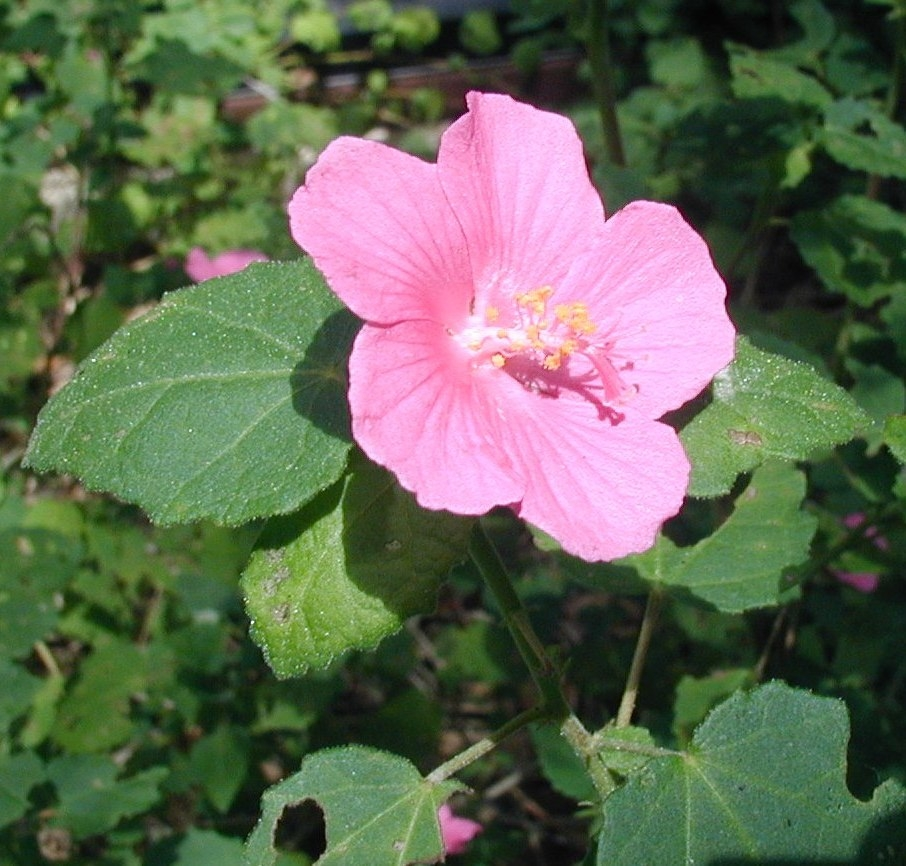Author: Bill Ward
Hill Country summers are hard on most flowering plants, even native plants. By July many blooming wildflowers and shrubs, whether in the wild or in the garden, are in a summer slump. However, one little native shrub that keeps blooming through the heat and on into the fall is rose pavonia, the Operation NICE! (Natives Instead of the Common Exotics!) plant for June. Other common names by which this plant is known are rose mallow, rockrose, and Wright’s pavonia.
Rose pavonia (Pavonia lasiopetala) is one of those worth-repeating Plants of the Month. It was the NICE! plant for July 2002. When I wrote about it seven years ago, I had only seen it in gardens. Since then, I’ve been lucky enough to find it blooming in the wild near Montell and Concan in northern Uvalde County.
Now I know why rose pavonia is a hardy, drought-tolerant shrub good for our Hill Country landscapes. In its native habitat it can withstand the harsh conditions of dry, thin limestone soils. It grows both in sunny and partly shady spots.

Specimens of rose pavonia in the University of Texas and Sul Ross University herbariums were collected along the eastern and southern edges of the Edwards Plateau out to the near-Trans Pecos area of Terrell County. Reportedly, this plant also is native to parts of the Rio Grande Plain of South Texas. It is not reported in Kendall County, but apparently rose pavonia has been collected many times in Comal County. Has anyone seen it in the wild in Kendall County?
The rose-pink blooms resemble miniature hibiscus flowers. The blooms are small, only an inch or so wide, but usually are abundant. Flowers have a prominent yellow stamen column in the center of the five petals. The long bloom period is from late spring until a hard frost in the fall. Pavonia grows to about three feet high and can spread out a few feet wide.
Rose pavonia seems as tough as it is attractive. Several years ago our generous neighbors across the street gave us a couple of pavonia plants from their yard, but the transfer was not delicate. Tom came over with two blooming plants he had pulled up by the roots. I planted the bare-rooted pavonias without preparing any special soil, but made sure they stayed moist. In a few days the plants had survived the shock and began to put on new leaves and blooms. Once established, they did not require much watering.
Rose pavonia also is resistant to cold. Ours usually survive all but the hardest freezes. When we first started growing this little shrub, I was surprised that one plant did not come back from the late-winter freeze. However, a smaller plant that had come up near the dead plant had survived the frigid weather very well. Why was the smaller plant the tougher of the two?
I found the answer to my question in “Native Texas Plants – Landscaping Region by Region” by Sally and Andy Wasowski and “How to Grow Native Plants of Texas and the Southwest” by Jill Nokes. According to these authors, it is normal for pavonia bushes to decline after three or four years. That is not the problem it might seem. Rose pavonia easily self-seeds, and there will be younger plants coming up to replace the older ones.
Rose pavonia usually is available in local nurseries. The Boerne Chapter of the Native Plant Society of Texas provides free planting and care instructions for rose pavonia at nurseries participating in Operation NICE! (Hill Country African Violets and Nursery and Maldonado Landscape and Nursery) and at the Cibolo Nature Center.


